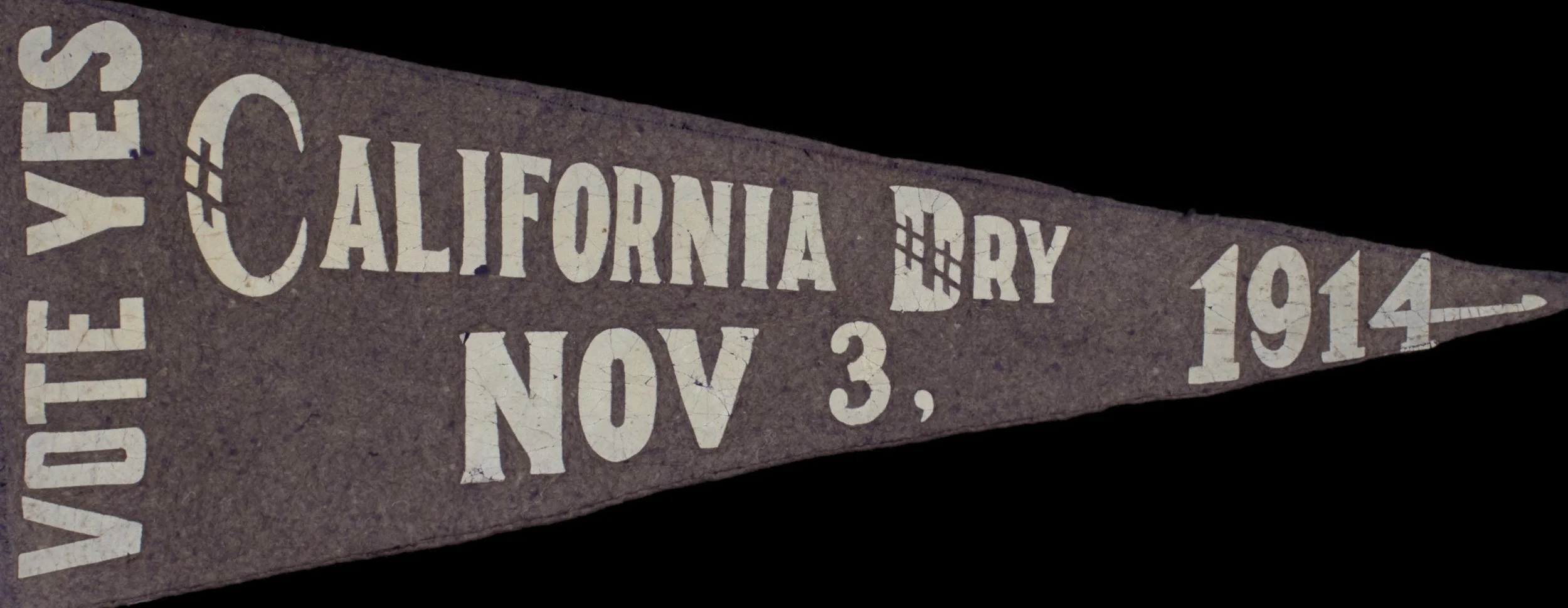Exceptional California Dry Movement Pennant | The Only Example We Have Encountered | Circa 1914
Exceptional California Dry Movement Pennant | The Only Example We Have Encountered | Circa 1914
Frame Size (H x L): 36” x 20.75”
Pennant Size (H x L): 26” x 10”
Offered is an antique prohibition pennant in the classic elongated triangular form, tapering sharply to a point. The background is a muted purple. White lettering is arranged in a bold, visually balanced layout. Along the hoist edge, “VOTE YES” appears vertically in tall block letters, setting a strong tone.
Centered on the pennant is the rallying cry: “CALIFORNIA DRY.” “CALIFORNIA” is rendered in large capital letters, with “DRY” below it in a slightly smaller font. Notably, the “D” in “DRY” contains tally marks—five lines crossed diagonally—suggesting themes of voting and civic action. Below, “NOV 3” anchors the design in time.
At the pointed tip, “1914” runs horizontally, underlined with a stylized line that draws the eye to the end. The typography shifts subtly to fit the space, maintaining clarity while enhancing the urgency of its original message.
This pennant commemorates a pivotal moment in California’s history, set against the backdrop of the early 20th-century temperance movement. By 1914, national momentum for prohibition was surging, fueled by decades of grassroots advocacy from organizations like the Anti-Saloon League and the Woman’s Christian Temperance Union. These groups saw alcohol as a root cause of societal ills—crime, poverty, domestic violence, and moral decay—and worked tirelessly to bring about change.
The slogan “California Dry” was part of a statewide campaign urging voters to support a ban on the manufacture and sale of alcohol. The scheduled vote on November 3, 1914, marked California’s own reckoning with the growing national call for temperance.
Although California voters ultimately rejected the prohibition measure in 1914, the campaign was emblematic of a broader cultural shift that culminated just a few years later. By 1919, the 18th Amendment had been ratified, launching national Prohibition in 1920. But that national effort was built on years of local and state-level battles, battles like the one this pennant represents. In fact, many counties and municipalities in California had already gone “dry” prior to the statewide vote, adopting local ordinances in response to public pressure.
The 1914 campaign also reflected a deeper clash of values within California itself. Urban centers like San Francisco and Los Angeles—with their diverse immigrant populations and thriving nightlife—largely opposed prohibition. In contrast, rural and religious communities were more inclined to support it. The debate underscored broader societal tensions: progressivism vs. personal liberty, tradition vs. modernization, rural conservatism vs. urban dynamism.
The temperance movement in California was further complicated by the state’s unique cultural and demographic makeup. California was home to large immigrant communities—particularly from Italy, Germany, and China—many of whom brought longstanding cultural traditions involving alcohol, whether in winemaking, beer brewing, or social consumption. These communities viewed prohibition as an assault not only on personal freedom but on cultural identity itself. As a result, anti-prohibition forces in the state often framed their opposition in terms of civil rights, economic livelihood, and ethnic representation, further polarizing the electorate.
Despite the 1914 defeat, California would continue to play a nuanced role in the prohibition era. While the state never passed a sweeping statewide ban, numerous towns and counties enacted local prohibition laws, creating a patchwork of dry and wet jurisdictions. These localized efforts mirrored national trends, where enforcement varied widely and resistance was often spirited. California’s complex geography, extensive coastline, and border with Mexico also made it a hotbed for bootlegging and smuggling during national prohibition—an unintended consequence that revealed the limitations of enforcement and foreshadowed the law’s eventual repeal.
The slogan “Vote Yes California Dry” was more than a political message—it was a call for moral reform, social order, and a vision of a better society during a time of rapid change.
Today, this pennant stands as a artifact of grassroots activism and civic mobilization. It captures a moment when Americans were deeply engaged in questions about the role of government, personal responsibility, and the power of collective action. While national Prohibition would ultimately be repealed in 1933 with the 21st Amendment, the legacy of the movement—its fervor, its controversy, and its impact—echoes in the stories of campaigns like California’s 1914 vote.
Conservation Process: This pennant was hand sewn to cotton fabric, and both were hand sewn to a mounting board. To prevent the black dye in the cotton fabric from seeping into the pennant, the fabric was first washed in a standard wash and then in a dye setting wash. The pennant is positioned behind Optium Museum Acrylic.
Frame: Framed in a matte black wood frame with subtle grain texture, the presentation is both understated and elegant.
Condition Report: The pennant shows moderate fading consistent with age, but the lettering remains bold and legible. The felt is intact with no major flaws, making it a well-preserved example of early political ephemera.
Collectability Level: The Great – Perfect for Rising Collectors
Date of Origin: 1914











